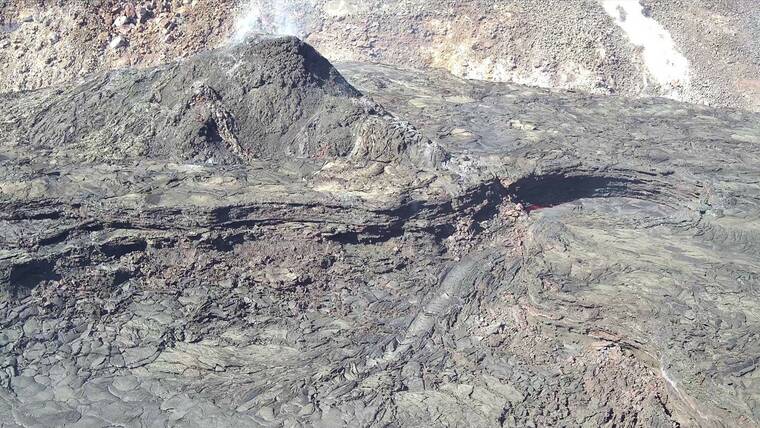The ongoing summit eruption at Kilauea volcano turned 1 year old on Sept. 29, 2022. The past year’s activity has commonly been described as “continuous” effusion of lava within Halema‘uma‘u crater. Although this has been mostly true — especially in recent months — there have been multiple occasions when lava was not flowing. What happened at those times, and why?
During the late fall and winter of 2021–2022, the eruption would episodically pause for periods lasting from hours to days. These pauses typically occurred in conjunction with deflation-inflation (DI) events in the summit magma reservoir, as recorded by USGS Hawaiian Volcano Observatory tiltmeters in the region.
As the summit deflated the surface of the active lava lake would drop, eventually settling about 10 meters below the rim of the surrounding levees. At this point the lava would crust over, except for a small active pond near the western eruptive vent. Notably, during each pause there was also a substantial reduction in sulfur dioxide (SO2) emissions, suggesting that little to no magma was rising in the shallow conduit below the eruptive vent.
When the summit reinflated to a critical point, lava would flow from this pond to slowly refill the lava lake. Surges of lava followed many of the pauses and often caused overflows from the active lake onto large sections of the surrounding crater floor. Breakouts of lava from around the circumference of the crater floor were also common during eruption restarts. These events were responsible for significantly thickening the crust making up the current crater floor.
Why did these pauses occur? HVO scientists are still exploring this question. The pauses were clearly associated with DI events during this period. However, many other DI events occurred both before and after the period of pauses last fall and winter. The DI events associated with pauses were not particularly large and some were tiny compared to many of those that preceded and followed the period of pauses. It remains curious why some of these DI events shut down the eruption while others caused only minor fluctuations in activity.
The last pause to date occurred on March 18, and since then there has been truly (or mostly truly) continuous lava effusion. The crater floor has also continued to rise due to lava spreading from the active lake to areas beneath the crust. This “endogenous” injection of lava lifts the crater floor, like the inflation of an air mattress.
The eruptive activity at Kilauea summit was disrupted one more time on September 20, when a swarm of several dozen earthquakes occurred below Halema‘uma‘u. Simultaneously, tiltmeters measured rapid inflation in the summit region. Around 4:30 p.m. webcams recorded the higher central part of the crater floor dropping by several meters at the same time breakouts occurred along the lower margins of the crater floor. The earthquakes and inflationary tilt soon tailed off followed by the return of steady activity within the lava lake.
Initial observations suggested that the conduit to the eruptive vent may have experienced a structural failure — allowing dense lava below the crater floor to infiltrate the conduit, causing it to clog. Geophysical data from this event and the following days tell a very different story. Interferometric Synthetic Aperture Radar (InSAR) data from satellites show that an area around the west side of Halema‘uma‘u crater uplifted by a couple centimeters around September 20. Modeling of the seismicity and deformation by HVO scientists indicates that a horizontal body of magma, called a sill, may have been intruded between old layers of lava below the crater that day.
The fact that the summit inflated on Sept. 20, but never deflated in association with the new lava breakouts, is consistent with the accumulation of magma somewhere below ground. The drop of the crater floor suggests the possibility that some lava may have drained back down the conduit to form part of the sill as well. As data collection continues, we hope to learn even more about the volcanic processes that influence and control eruptive pauses and sill formation at Kilauea volcano.
Volcano
activity updates
Kilauea volcano is erupting. Its USGS Volcano Alert level is at WATCH (https://www.usgs.gov/natural-hazards/volcano-hazards/about-alert-levels). Kilauea updates are issued daily.
Over the past week, lava has continued to erupt from the western vent within Halema‘uma‘u crater in Hawai‘i Volcanoes National Park. Sulfur dioxide emission rates remain elevated and were last measured at approximately 1,800 tonnes per day (t/d) on Sept. 30. Seismicity is elevated but stable, with few earthquakes and ongoing volcanic tremor. Over the past week, summit tiltmeters recorded two deflation-inflation (DI) events. For more information on the current eruption of Kilauea, see https://www.usgs.gov/volcanoes/Kilauea/recent-eruption.
Mauna Loa is not erupting and remains at Volcano Alert Level ADVISORY. This alert level does not mean that an eruption is imminent or that progression to an eruption from the current level of unrest is certain. Mauna Loa updates are issued daily.
This past week, about 245 small-magnitude earthquakes were recorded below the summit and upper elevation flanks of Mauna Loa — the majority of these occurred at shallow depths less than 15 kilometers (9 miles) below sea level. Global Positioning System (GPS) measurements show continued ground deformation consistent with inflation of a magma chamber beneath the summit. Gas concentrations and fumarole temperatures at both the summit and at Sulphur Cone on the Southwest Rift Zone have remained stable over the past week. Webcams show no changes to the landscape. For more information on current monitoring of Mauna Loa, see: https://www.usgs.gov/volcanoes/mauna-loa/monitoring.
There were 13 events with 3 or more felt reports in the Hawaiian Islands during the past week. Listed here are the felt events with magnitudes of 3 and above: a M3.1 earthquake 25 km (15 mi) E of Honaunau-Napoopoo at 0 km (0 mi) depth on Oct. 16 at 7:36 p.m. HST, a M3.6 earthquake 9 km (5 mi) S of Pahala at 12 km (8 mi) depth on Oct. 14 at 3:05 p.m. HST, a M3.9 earthquake 6 km (3 mi) S of Pahala at 10 km (6 mi) depth on Oct. 14 at 10:12 a.m. HST, a M4.0 earthquake 9 km (5 mi) SSW of Pahala at 11 km (6 mi) depth on Oct. 14 at 9:16 a.m. HST, a M5.0 earthquake 7 km (4 mi) SSW of Pahala at 8 km (5 mi) depth on Oct. 14 at 9:07 a.m. HST, and a M4.6 earthquake 8 km (5 mi) S of Pahala at 11 km (7 mi) depth on Oct. 14 at 9:07 a.m. HST.
Please visit HVO’s website for past Volcano Watch articles, Kilauea and Mauna Loa updates and more. Email questions to askHVO@usgs.gov.






